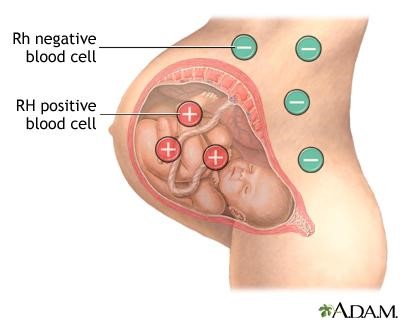A pregnant client in her second trimester has a hemoglobin level of 11 g/dL. The nurse interprets this as indicating
Hemodilution of pregnancy
A multiple gestation pregnancy
Greater-than-expected weight gain
Iron-deficiency anemia
The Correct Answer is A
Choice A: Hemodilution of pregnancy is a normal physiological phenomenon that occurs when the plasma volume increases more than the red blood cell mass, resulting in a lower hemoglobin concentration. The normal hemoglobin range for pregnant women in the second trimester is 10.5 to 14 g/dL.
Choice B: A multiple gestation pregnancy may cause a higher hemoglobin level due to increased erythropoietin production by the placenta. The normal hemoglobin range for pregnant women with twins in the second trimester is 12 to 16 g/dL.
Choice C: Greater-than-expected weight gain is not related to hemoglobin level. Weight gain during pregnancy depends on various factors such as pre-pregnancy weight, nutrition, activity level, and fetal growth.
Choice D: Iron-deficiency anemia is a condition where the hemoglobin level is below the normal range due to inadequate iron intake or absorption, blood loss, or increased iron demand. The signs and symptoms of iron-deficiency anemia include fatigue, pallor, weakness, shortness of breath, and pica.
Nursing Test Bank
Naxlex Comprehensive Predictor Exams
Related Questions
Correct Answer is C
Explanation
Choice A Reason: This is incorrect because administering Rho(D) immune globulin 24 hours before delivery is too early and may not provide adequate protection for the fetus. Administering it 24 hours after delivery is too late and may not prevent the mother from developing antibodies against the fetal Rh-positive blood cells.
Choice B Reason: This is incorrect because administering Rho(D) immune globulin in the first trimester is unnecessary and may not be effective, as the risk of Rh isoimmunization is very low before 28 weeks of gestation. Administering it within 2 hours of delivery is appropriate, but not sufficient, as it should be repeated within 72 hours after delivery.
Choice C Reason: This is correct because administering Rho(D) immune globulin at 28 weeks gestation and again within 72 hours after delivery is the recommended schedule for preventing Rh isoimmunization in Rh-negative pregnant women who have Rh-positive partners. This regimen can prevent up to 99% of cases of Rh isoimmunization by blocking the maternal immune response to the fetal Rh-positive blood cells.
Choice D Reason: This is incorrect because administering Rho(D) immune globulin at 32 weeks gestation is too late and may not prevent Rh isoimmunization if there has been any fetal-maternal hemorrhage before that time. Administering it immediately before discharge is also too late and may not prevent the mother from developing antibodies against the fetal Rh-positive blood cells.

Correct Answer is C
Explanation
Choice A Reason: This option is incorrect because it is unrealistic and impractical to eliminate anxiety completely. Anxiety is a normal and natural response to pregnancy and childbirth, and it can have both positive and negative effects on the outcome. Anxiety can motivate women and their partners to seek information and care, but it can also interfere with their ability to relax and cope with pain. Perinatal education can help them manage their anxiety by providing accurate information, reassurance, and coping strategies.
Choice B Reason: This option is incorrect because it implies that the couple has no control over their pregnancy and birth unless they are empowered by perinatal education. While perinatal education can enhance their sense of control and autonomy, it is not the only factor that influences their experience. Pregnancy and birth are complex and dynamic processes that involve many factors beyond their control, such as biological, environmental, social, and cultural factors. Perinatal education can help them adapt to these factors and collaborate with their health care providers.
Choice C Reason: Perinatal education is a process of providing information and support to pregnant women and their partners before, during, and after childbirth. The main goal of perinatal education is to help them prepare for a positive birth experience, which can have lasting benefits for their physical and emotional health, as well as their relationship with their baby. Perinatal education can also help them make informed decisions about their care and preferences, and cope with any challenges or complications that may arise.
Choice D Reason: This option is incorrect because it is too narrow and limited in scope. Providing knowledge and skills that will help them cope with labor is an important aspect of perinatal education, but it is not the primary goal. Labor is only one stage of childbirth, and perinatal education covers a broader range of topics that are relevant for pregnancy, birth, and postpartum. Moreover, coping with labor is not the only outcome that matters for a positive birth experience. Perinatal education can also help them achieve other outcomes, such as satisfaction, empowerment, bonding, and well-being.
Whether you are a student looking to ace your exams or a practicing nurse seeking to enhance your expertise , our nursing education contents will empower you with the confidence and competence to make a difference in the lives of patients and become a respected leader in the healthcare field.
Visit Naxlex, invest in your future and unlock endless possibilities with our unparalleled nursing education contents today
Report Wrong Answer on the Current Question
Do you disagree with the answer? If yes, what is your expected answer? Explain.
Kindly be descriptive with the issue you are facing.
